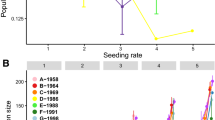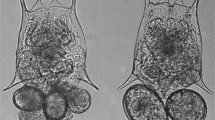Abstract
Species of Daphnia (Crustacea: Cladocera) typically reproduce by cyclical parthenogenesis, in which a period of all-female parthenogenetic reproduction is followed by sexual reproduction. Sex in Daphnia is determined by the environment, with factors such as temperature, photoperiod and crowding stimulating the production of males and sexual females. Previous studies on Daphnia pulex from temporary pond habitats demonstrated the coexistence of male-producing and non-male-producing (NMP) females, as determined under crowding in the laboratory. A strong genetic component to this sex allocation variation suggested that sex expression in D. pulex is better described as a result of genotype-environment interaction. The present study examined the switch from parthenogenetic to sexual reproduction in two temporary-pond populations of D. pulex. Both populations showed a very early investment in sexual reproduction, independent of population density, by producing males very soon after the populations were reestablished from resting eggs in the early spring. Approximately 40% of the initial broods were male. Additional evidence for gender specialization was obtained by observing the sex of two or three successive broods for 85 individual females. Fifty-eight females produced successive broods of females, 13 females produced successive broods of males and 14 females produced successive broods which included both male and female broods. Females that produced successive female broods under natural conditions included a higher frequency of NMP females compared to a random sample of females, confirming the existence of NMP females. Sexual females were observed in both populations after the first appearence of males, suggesting that the presence of males may stimulate the production of sexual females. For D. pulex populations in a temporary environment, there appears to be an increased emphasis on sexual reproduction and a decreased influence of the environment on sex determination, compared to Daphnia populations in more permanent habitats.
Similar content being viewed by others
Author information
Authors and Affiliations
Additional information
Received: 19 February 1996 / Accepted: 20 January 1997
Rights and permissions
About this article
Cite this article
Innes, D. Sexual reproduction of Daphnia pulex in a temporary habitat. Oecologia 111, 53–60 (1997). https://doi.org/10.1007/s004420050207
Issue Date:
DOI: https://doi.org/10.1007/s004420050207




